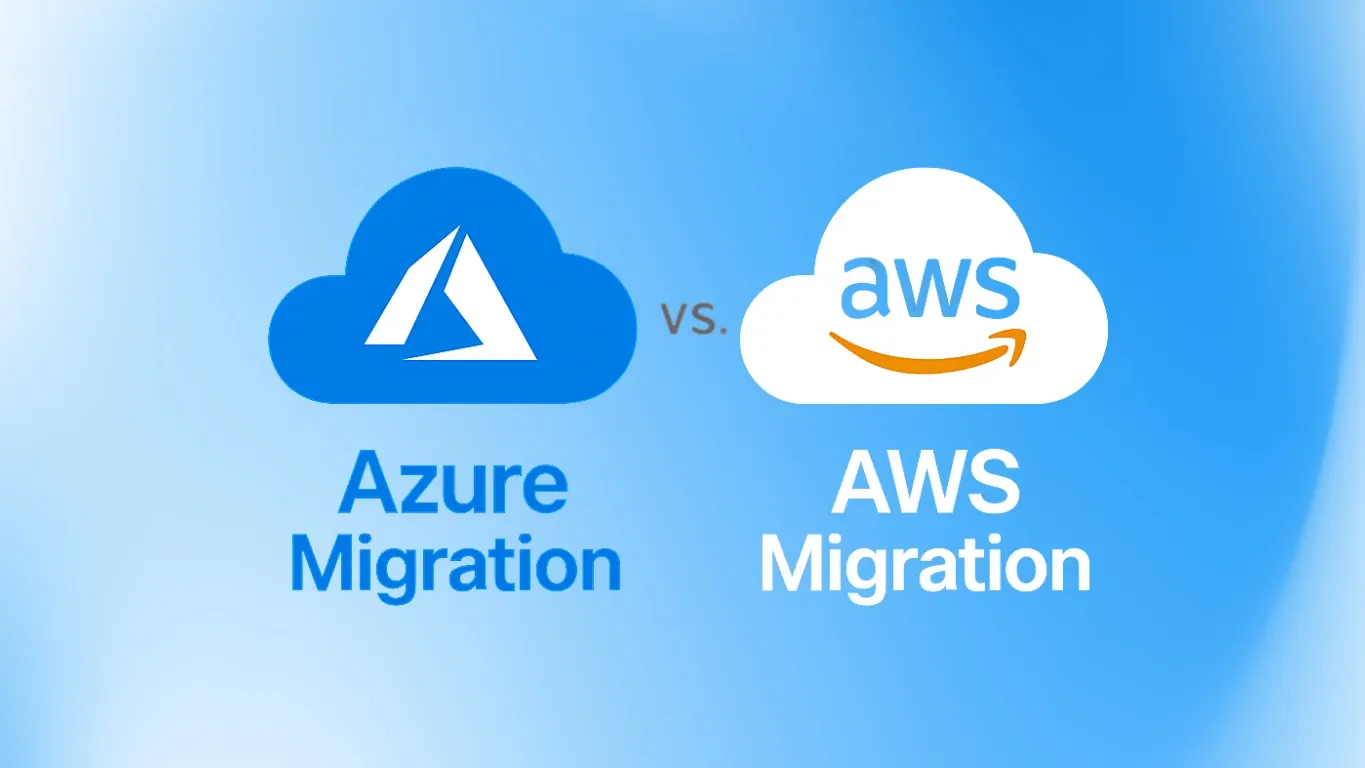Comparing Azure Migration and AWS Migration Key Differences in Cloud Strategy
Comparing Azure and AWS for cloud migration? Learn the key differences in pricing, security, tools, and performance to choose the right platform for your business.

Comparing Azure Migration and AWS Migration: Key Differences in Cloud Strategy
Migrating to the cloud has proven crucial in recent years as it can streamline a company’s operations and help them stay competitive in an increasingly digital landscape. Yet, migrating to the cloud is a massive undertaking, and it is important that you take the time to develop a cloud migration strategy to ensure efficiency and keep costs down. However, before you can develop a migration strategy, you must first decide which cloud provider is right for your business.
The two biggest cloud providers that you’re likely debating between are Amazon Web Services (AWS) and Microsoft Azure, as they both offer a wide range of cloud services and features designed to meet the needs of businesses of all sizes. However, the popularity of these two platforms, and their robust service offerings, can make choosing between them feel daunting. How can you tell which is better or what the differences between the two even are? To help you make this important decision, keep reading as we take an in-depth look at both Microsoft Azure and AWS, the differences between them, and how you’ll know which one is right for your business.
Overview of Azure and AWS Cloud Migration
You’ve likely heard of Microsoft Azure and Amazon Web Services, as they are the biggest cloud service providers, holding 24% and 31% of the market, respectively. Yet, you may not be sure what sets them apart or what services and features they provide. Let’s start by taking a quick look at each of these platforms.
Microsoft Azure
We’ll start with Microsoft’s cloud service, Azure, as this is the one you’ve likely heard the most about. Microsoft Azure is a set of cloud services that offers businesses of all sizes a range of valuable features and functionalities such as analytics, storage, computing, and networking. Azure is the most widely available cloud service, as it covers 163 availability zones in 79 regions, far exceeding any other provider, including AWS.
Amazon Web Services (AWS)
While Microsoft is by far the most recognizable name in the cloud service provider landscape, Amazon’s AWS is another popular choice that offers a comprehensive suite of cloud computing services. AWS provides users with access to over 200 features and services, including computing power, storage, databases on demand, networking, analytics, and more. AWS has grown exponentially in recent years and is now available to customers in 102 availability zones across 32 geographic regions.
Key Similarities
As the two biggest cloud service providers, Azure and AWS have many similarities in their service offerings, as they both provide users with access to a wide range of services and features, including core services like cloud computing, storage, databases, and networking. Additionally, they both provide robust security features, have a global reach, and provide support for hybrid cloud architectures. Both platforms also offer robust monitoring, machine learning, and serverless computing capabilities, as well as IaaS, PaaS, and scalability options. The overlap in features provided by each of these services can then make it difficult to know which is right for your business. To help you decide, we will be looking next at the key differences between these two platforms.
Key Differences Between Azure and AWS Migration
While Azure and AWS offer many similar services and features, there are key differences that set the two apart. Knowing these differences can then help you determine which service will work best for your business. A few of the primary differences between these services include:
Cloud Adoption and Enterprise Integration
One of the biggest differences between Azure and AWS is that, since Azure is run by Microsoft, it integrates natively with Microsoft systems. This makes Azure ideal for Microsoft-centric enterprises using Windows Server, SQL, and Active Directory. Alternatively, AWS is often preferred by tech startups and developers who prefer to use open-source solutions or Linux-based systems.
Migration Tools and Services
Azure and AWS also differ in the migration tools and services they utilize, as both offer integrated migration tools. Microsoft Azure has Azure Migrate for assessment and planning, as well as Azure Site Recovery for disaster recovery. Alternatively, AWS provides users with AWS Migration Hub for Tracking and Automation, as well as AWS Server Migration Service (SMS) for VM migration.
Pricing Models and Cost Optimization
While both Azure and AWS use a pay-as-you-go pricing model with additional savings offered for long-term commitments, AWS provides a wider range of pricing options, which can make things confusing for new users looking to predict their cloud costs. Many companies prefer Azure due to its straightforward pricing as well as the discounts it provides Microsoft Enterprise customers. However, once you understand AWS’s pricing models, AWS can offer users much more pricing flexibility.
Security and Compliance
Another significant difference between Azure and AWS can be seen in the security and compliance features they provide. Azure has built-in compliance with Microsoft 365 security policies, and the Azure Security Center provides unified security management. With access to robust security and compliance features, Azure is generally considered the preferred choice for government contractors who must comply with regulations such as FAR, DFARS, and CMMC. While AWS does offer some strong compliance features, it requires third-party tools for full visibility.
Hybrid and Multi-Cloud Support
If you’re interested in hybrid cloud solutions, Azure is the way to go, as it offers comprehensive hybrid cloud solutions with Azure Arc and Azure Stack. While AWS offers multi-cloud support via AWS Outpost, its hybrid solutions are limited.
Which Cloud Platform is Right for Your Business?
So, how will you know which cloud platform is right for your business? This will ultimately come down to personal preference as well as your organization’s specific needs. Since both platforms offer similar services, your decision will likely come down to a few key details. To help you choose, here’s a brief look at scenarios where choosing each provider makes the most sense:
Choose Azure If:
Microsoft Azure will likely be the best choice for your business if:
- Your company relies on Microsoft services like Windows, SQL, and M365.
- You need hybrid cloud support for on-premises integration.
- You want to access a broad range of managed services and prefab capabilities that you can access immediately.
- Compliance and security are major concerns, particularly if you handle government contracts and must comply with DFARS, CMMC, or FAR.
Choose AWS If:
Alternatively, you should consider choosing AWS if the following apply:
- Your company is looking for an Infrastructure-as-a-Service (IaaS) solution that doesn’t restrict your choice of technology. While AWS provides fewer pre-integrated tools, it does not restrict you as much from using open-source components.
- You need more customizable cloud-native services.
- You want greater scalability.
Migration Best Practices for Azure and AWS
Once you’ve settled on a cloud service provider, your next task will be to plan out your cloud migration. Ensuring this process goes smoothly will require careful preparation and monitoring. A few best practices you can follow to ensure a well-executed migration include:
- Assess Workloads Before Migration: Your first step will be to evaluate your applications and workloads to determine if they are suitable to be moved to the cloud. Make sure to prioritize workloads based on their complexity, dependencies, and value to your business.
- Use Migration Tools: Simplify the migration process by using the right tools for the job. Both Azure and AWS have built-in tools to help users simplify the migration process, including Azure Migrate and AWS Migration Hub, which act as central hubs for planning, executing, and monitoring migrations.
- Optimize Costs: Leverage cost management tools such as Azure Reserved Instances and Azure Cost Management from the start to help monitor and optimize cloud spending.
- Monitor Post-Migration Performance: The long-term success of your cloud migration requires you to constantly monitor performance, analytics, and security following migration to ensure the health and safety of your cloud implementation. Take advantage of automated monitoring tools and use this data to continually optimize your cloud performance.
While Microsoft Azure and Amazon’s AWS offer many similar features and services, they differ significantly in their integration capabilities, pricing models, and compliance features. Therefore, the best cloud platform for you will depend on your business’s needs, including your security and integration requirements.
Of course, if you aren’t sure where to start with your cloud migration or which cloud service provider you should choose, the good news is that you don’t have to go through this process alone. Outsourcing your cloud migration to a managed service provider (MSP) can help streamline this process and provide you with peace of mind knowing that you have seasoned professionals guiding you through this process.
Do you need help choosing between Azure and AWS? Not sure how to start your cloud migration? Feel free to contact Agile IT today for expert guidance.





